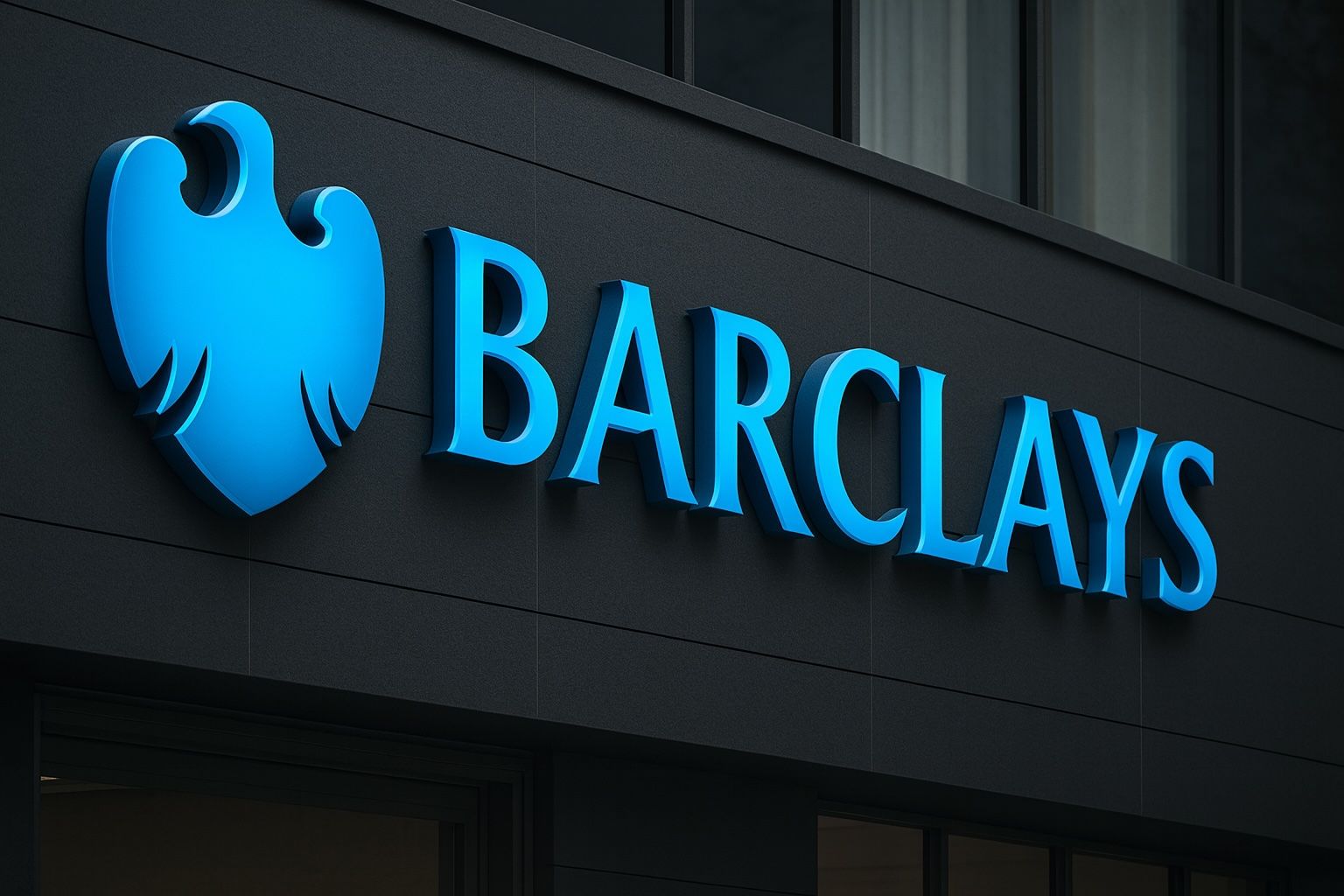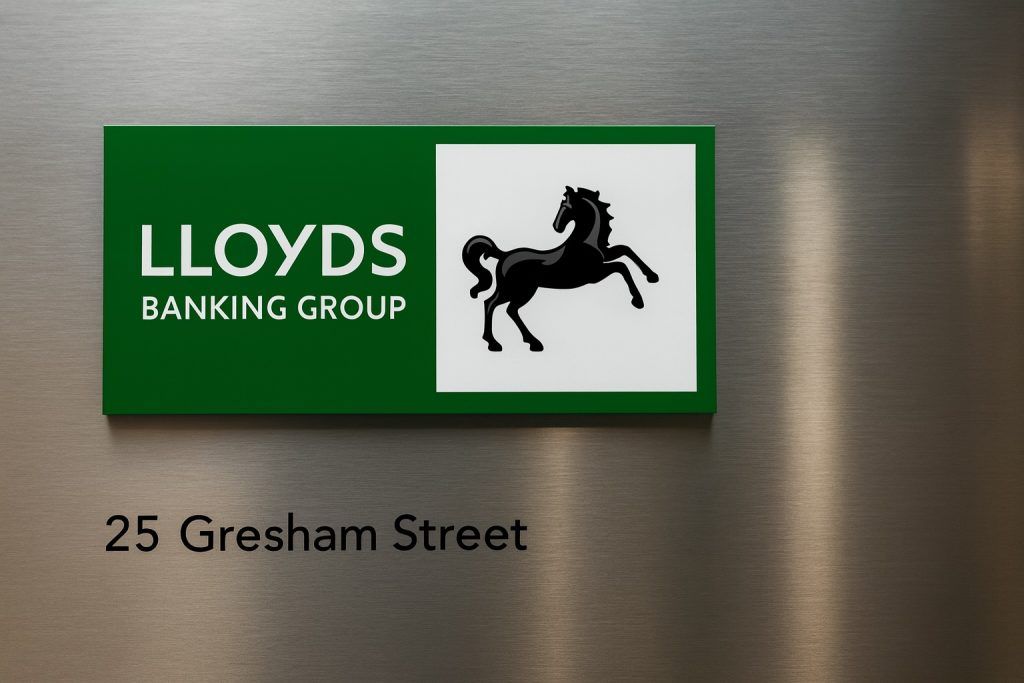Barclays heads into Monday’s session sitting near multi‑year highs, after a powerful rerating driven by stronger profits, upgraded guidance and chunky share buybacks – but also shadowed by fresh regulatory fines and a growing motor‑finance redress bill. Here’s what traders and longer‑term investors should have on their radar before the London Stock Exchange opens on Monday, 17 November 2025.
1. Where the Barclays share price stands before Monday’s open
Barclays’ London‑listed shares (LSE: BARC) closed on Friday 14 November 2025 at around 413.8p, down about 3.2% on the day from a previous close of 427.25p. In Friday’s session the stock traded between roughly 409.6p and 424.2p, with heavy volume close to 35m shares changing hands. [1]
Despite Friday’s pull‑back, the move comes after a huge run:
- The one‑year performance sits at about +61%, making Barclays one of the standout performers in the FTSE 100 over the past 12 months. [2]
- The shares are trading close to a 52‑week and five‑year high around 430–431p, versus a 52‑week low near 224p, underlining how far sentiment has recovered from the 2023–24 trough. [3]
In the U.S., the New York‑listed ADR (NYSE: BCS) closed on Friday at $21.70, down 2.47% on the day but still up more than 67% over the past year, reflecting global investors’ enthusiasm for the name. [4]
In other words, Barclays goes into Monday’s London open as a strong momentum stock that just experienced a bout of profit‑taking after bumping up against new highs.
2. Short‑term technical picture: levels to watch on 17 November
From a short‑term trading perspective, there are a few key points to note:
- Trend still up: Both daily and multi‑month performance metrics from Hargreaves Lansdown show Barclays comfortably above its 3‑month and 6‑month levels, with the share price up around 29% over six months and more than 10% over three months. [5]
- Volatility: Friday’s intraday move of just over 2% was in line with the stock’s recent average daily volatility (around 1.7–2%). [6]
- Support and resistance: Technical analysis service StockInvest flags support around 406–407p and near‑term resistance in the 420–423p region, where accumulated volume and prior peaks cluster. [7]
StockInvest’s model projects a “fair” opening price on Monday of about 414p, with a statistically expected intraday range between roughly 409p and 418p, based on the 14‑day Average True Range. [8]
Those figures are model‑based estimates, not guarantees. They do, however, give traders a sense of the band within which short‑term moves have recently been contained.
Practical takeaway: For day‑traders, the 406–407p zone may be watched as first support, while any push back towards 425–430p tests the recent breakout area where profit‑taking has been occurring.
3. The fundamental engine: Q3 2025 results and upgraded guidance
The biggest single driver of Barclays’ re‑rating this year has been solid operational momentum, most recently showcased in its Q3 2025 results released on 22 October.
Key numbers from the Q3 update and earnings call include: [9]
- Top‑line income: Up around 11% year‑on‑year to £7.2bn.
- Return on tangible equity (RoTE):
- 10.6% for Q3 alone.
- 12.3% year‑to‑date, prompting management to upgrade 2025 RoTE guidance to “>11%” and reaffirm a >12% target for 2026.
- Net interest income (NII):
- Group NII expected to be “more than £12.6bn” in 2025 (raised from >£12.5bn).
- Barclays UK NII guided to >£7.6bn for 2025.
- Capital strength:
- CET1 ratio of 14.1% (about 13.9% after allowing for a new buyback).
- Management achieved about £500m of gross efficiency savings for 2025 one quarter early, with a £2bn savings target by end‑2026.
- Capital returns:
- A fresh £500m share buyback was announced alongside Q3.
- The bank reiterated its plan to return at least £10bn of capital over 2024–26, via dividends and buybacks.
All major divisions recorded double‑digit RoTE in Q3, with particularly strong numbers in Barclays UK (over 21%) and the corporate bank, while the investment bank and U.S. consumer operations also showed improved profitability. [10]
These figures help explain why the market has been willing to move Barclays’ valuation closer to that of other large European banks after years of trading at a steep discount.
4. The big overhang: motor‑finance redress and other regulatory issues
The main fly in the ointment is legacy conduct and regulatory risk, which is still very much alive.
Motor‑finance compensation scheme
The UK Financial Conduct Authority (FCA) is consulting on an industry‑wide redress scheme for customers who may have been sold car finance on unfair commission terms. [11]
- The FCA estimates the potential industry bill at £8.2bn–£9.7bn. [12]
- In response, Barclays tripled its provision for potential motor‑finance redress from £90m to £325m, taking an additional £235m charge in Q3 2025. [13]
- That extra charge is expected to shave roughly 5 basis points off the group’s CET1 capital ratio. [14]
Together with a £110m impairment linked to the collapse of U.S. subprime auto lender Tricolor, these provisions contributed to Q3 pre‑tax profit falling about 7% year‑on‑year to £2.1bn, despite the strong revenue growth. [15]
Financial‑crime controls and fines
In July 2025 the FCA fined Barclays £42m for serious failings in anti‑money‑laundering controls linked to clients including Stunt & Co and WealthTek. [16]
While Barclays self‑reported and cooperated, reducing the ultimate penalty, the case underlines:
- Ongoing regulatory scrutiny of the bank’s controls.
- The reputational cost of legacy issues, arriving at the same time as broader conduct debates over motor‑finance commissions.
On top of that, the FCA has now formally banned former CEO Jes Staley from senior roles in financial services after a long‑running investigation into how he described his relationship with Jeffrey Epstein. [17]
Why this matters for Monday’s open:
Although these issues are already in the price to some degree, any new signals from the FCA or government on redress costs or criminal‑risk enforcement could quickly feed into sentiment toward UK bank stocks – particularly after such a large year‑to‑date rally.
5. Strategy moves: U.S. consumer push, Middle East build‑out and growth‑debt bets
Barclays has been busy reshaping and expanding parts of the franchise – another important backdrop to the current share price.
5.1. Best Egg acquisition in the U.S.
In late October, Barclays announced that its U.S. arm will acquire Best Egg, a direct‑to‑consumer personal‑loan origination platform, for about $800m. [18]
- The deal adds a sizeable U.S. consumer‑lending platform and several million customer relationships (Best Egg reports roughly 2m customers), deepening Barclays’ already significant credit‑card and consumer presence in America. [19]
- The price equates to a high single‑digit P/E multiple based on Best Egg’s earnings, suggesting Barclays believes there is further growth to come. [20]
This plays into management’s strategy of driving higher‑return growth in its U.S. consumer bank, one of the divisions targeted for mid‑teens RoTE in the medium term. [21]
5.2. Saudi Arabia and the wider Middle East
Barclays also continues to expand its presence in the Middle East:
- The bank has secured a provisional Capital Market Authority (CMA) licence in Saudi Arabia to restart investment banking activities, with a new Riyadh office scheduled to open in 2026. [22]
- Saudi Arabia is set to recognise Barclays’ regional headquarters in Riyadh, which the kingdom sees as a vote of confidence in its ambitions to be a regional financial hub. [23]
- The UK government recently announced £6.4bn of trade and investment deals with Saudi Arabia, with Barclays named among the firms participating in new investment agreements – underscoring the strategic importance of the region. [24]
5.3. Cornerstone investor in Salica Growth Debt Fund II
On the home front, Barclays has become a cornerstone investor in Salica Investments’ £150m Growth Debt Fund II, which provides flexible growth financing to fast‑growing, innovation‑led UK companies in software and IP‑rich hardware. [25]
The move supports Barclays’ Innovation Banking strategy, positioning the bank deeper into the UK venture and growth‑debt ecosystem – an area that can generate higher spreads, albeit with more credit risk.
5.4. Senior hires in France and Asia Pacific
Barclays is also investing in people:
- Marie‑Charlotte Etienne, previously co‑head of M&A in France at BNP Paribas, has joined Barclays as a Managing Director to lead M&A in France, Belgium and Luxembourg, strengthening the bank’s advisory firepower in Continental Europe. [26]
- The bank has appointed Jean‑François Mastrangelo as Head of Markets, Asia Pacific, signalling a push to grow its markets business across the region. [27]
These moves tie into external commentary – including a recent Reuters Breakingviews piece – suggesting that the “next chapter” for Barclays may include more M&A or targeted growth deals to rebalance the group toward higher‑return retail and corporate banking. [28]
6. Macro and policy backdrop: interest rates, inflation and bank taxes
6.1. Bank of England policy
At its meeting ending 5 November 2025, the Bank of England’s Monetary Policy Committee voted 5–4 to keep Bank Rate at 4%, with four members favouring a 25bp cut. [29]
- Inflation remains above the 2% target, but is expected to fall further.
- The BoE signalled that cuts could begin as soon as December, depending on incoming data. [30]
For banks like Barclays, this environment is a mixed bag:
- Higher‑for‑longer rates support net interest margins in the near term.
- But the prospect of future cuts means investors are already thinking about peak earnings and how quickly margins might compress.
The British Chambers of Commerce expects Bank Rate to stay around 4% through most of 2025, easing only to about 3.5% by end‑2026, which would still be a relatively supportive level for bank profitability compared with the pre‑2022 era. [31]
6.2. Bank taxes and the UK Budget
One notable recent boost for UK bank stocks was a Sharecast‑reported story on 6 November suggesting that Chancellor Rachel Reeves is minded to rule out sector‑specific tax hikes on banks in her upcoming Budget, even as she looks for revenue elsewhere to plug fiscal gaps. [32]
UK bank shares, including Barclays, rallied on the report, as fears of an increased bank levy or windfall tax had been an overhang earlier in the year.
For Monday’s open:
Unless there is fresh weekend reporting that changes expectations for the December BoE decision or the Budget, the macro backdrop is broadly supportive of current Barclays valuations – but leaves little room for disappointment if growth data weaken or political pressure for bank taxes re‑emerges.
7. Valuation, analyst views and sentiment
Even after the rally, several commentators argue that Barclays still looks attractively valued.
- Hargreaves Lansdown quotes a trailing P/E of about 11.9x and a dividend yield around 2%, with five‑year share‑price performance over 200% from the pandemic lows. [33]
- The Q3 earnings call and subsequent analysis from AlphaSense highlight that Barclays trades on a forward price‑to‑book ratio below 0.8x, still at a discount to both UK peers and major U.S. banks despite RoTE guidance above 11%. [34]
Recent external opinions:
- CFRA upgrade: Research firm CFRA raised its rating on Barclays ADR (BCS) from Hold to Buy on 23 October, lifting its price target from $21 to $24, citing stronger earnings quality, robust capital return plans and improved RoTE forecasts. [35]
- MoneyWeek feature (16 November 2025): MoneyWeek notes that Barclays’ profits are now more than double pre‑2019 levels, dividends have more than doubled, and the shares trade at less than 8x forecast 2026 earnings and at a discount to net asset value, making them look cheap relative to NatWest, Lloyds and HSBC. [36]
- IBD Composite Rating: Investor’s Business Daily recently highlighted the Barclays ADR’s Composite Rating rising from 94 to 96, meaning it now outranks roughly 96% of stocks in its system on combined fundamental and technical factors. [37]
At the same time, technical analysts (including StockInvest) have downgraded their very short‑term view from outright “Buy” to “Hold/Accumulate” after the latest surge, noting the risk of further cooling after a strong run. [38]
Big picture: The consensus narrative going into Monday is that Barclays is no longer the deeply distressed value play it once was, but may still offer reasonable upside if management delivers on upgraded RoTE targets and capital‑return promises – while successfully managing conduct and regulatory risks.
8. What could move Barclays share price at the open on 17 November?
Going into Monday’s London session, here are the main levers that could influence how BARC trades when the opening auction prints:
- Follow‑through from Friday’s weakness
- ADRs in New York fell on Friday and global risk appetite was slightly softer. If European indices open lower in sympathy with Wall Street, Barclays could see more short‑term profit‑taking after its recent 5‑year highs. [39]
- Rate‑cut expectations and macro data
- Any weekend commentary or leaks shifting the market’s view on a December BoE cut (for example, new inflation or wage data previews) could move UK bank stocks as a group at the open.
- Fresh signals on motor‑finance redress
- Investors are acutely sensitive to any hint that the FCA’s consultation might result in higher‑than‑expected compensation costs for the sector. New press leaks, political commentary or consumer‑group responses could weigh on Barclays’ price. [40]
- Regulatory or legal developments
- Additional news about the bank’s financial‑crime controls, or follow‑ups to the Jes Staley saga, would likely be treated as negative surprises, even if the direct financial impact is modest. [41]
- Sentiment toward UK banks and cyclicals
- Barclays now trades more like a cyclical “beta” play on UK and global growth than a pure deep‑value recovery stock. Moves in bond yields, sterling and FTSE 100 futures before the open will feed directly into BARC’s opening auction.
- Company‑specific surprises
- Any unscheduled Barclays announcement – such as another strategic deal, an update on the Best Egg acquisition, or further details on buybacks or capital plans – would overshadow the usual macro drivers. For now, none are flagged for Monday, but the market will be positioning ahead of the new medium‑term targets due with full‑year 2025 results in February. [42]
9. Key takeaways before the bell
Before the London market opens on 17 November 2025, the main things to know about the Barclays share price are:
- The stock is trading just below 5‑year highs, after a 60%+ 12‑month rally, with Friday’s drop looking more like healthy consolidation than a trend break (so far). [43]
- Fundamentals are strong: double‑digit RoTE, rising income, upgraded 2025 guidance, and a £10bn capital‑return programme underpin the bull case. [44]
- Risk isn’t gone: the £325m motor‑finance provision, potential industry‑wide redress bill, and £42m FCA fine for AML failings show that conduct and regulatory risks are still live. [45]
- Strategically, Barclays is leaning into growth – buying Best Egg in the U.S., expanding investment banking in Saudi Arabia, backing UK growth‑debt funds and hiring senior deal‑makers in France and Asia – all of which could support earnings but add execution risk. [46]
- Analyst and media sentiment has turned notably more positive, with CFRA upgrading to Buy, MoneyWeek calling the shares cheap versus peers, and IBD lifting its composite rating – even as short‑term technical models cool from “Buy” to “Hold/Accumulate.” [47]
For traders watching the opening auction, the critical questions on Monday will be whether:
- Buy‑the‑dip flows dominate now that the stock has pulled back a little from its highs, or
- Investors use the strength to take further profits, especially if broader risk sentiment turns cautious again.
Either way, Monday’s open is likely to be shaped less by brand‑new information and more by how the market digests the powerful re‑rating of the past year against the remaining regulatory and macro risks.
This article is for information only and does not constitute investment advice or a recommendation to buy or sell any security. Always do your own research or consult a regulated financial adviser before making investment decisions.
References
1. www.hl.co.uk, 2. www.hl.co.uk, 3. www.hl.co.uk, 4. www.financecharts.com, 5. www.hl.co.uk, 6. stockinvest.us, 7. stockinvest.us, 8. stockinvest.us, 9. www.hl.co.uk, 10. www.alpha-sense.com, 11. www.barclayspartnerfinance.com, 12. www.insurancejournal.com, 13. www.investegate.co.uk, 14. www.investegate.co.uk, 15. www.fstech.co.uk, 16. www.fca.org.uk, 17. www.ft.com, 18. www.investments.lloydsbank.com, 19. www.lse.co.uk, 20. www.lse.co.uk, 21. www.alpha-sense.com, 22. www.lse.co.uk, 23. www.reuters.com, 24. www.reuters.com, 25. financialit.net, 26. www.fnlondon.com, 27. home.barclays, 28. www.reuters.com, 29. www.bankofengland.co.uk, 30. www.theguardian.com, 31. www.britishchambers.org.uk, 32. www.redmayne.co.uk, 33. www.hl.co.uk, 34. www.alpha-sense.com, 35. www.insidermonkey.com, 36. moneyweek.com, 37. www.investors.com, 38. stockinvest.us, 39. www.financecharts.com, 40. www.insurancejournal.com, 41. www.fca.org.uk, 42. www.alpha-sense.com, 43. www.hl.co.uk, 44. www.investing.com, 45. www.investegate.co.uk, 46. www.lse.co.uk, 47. www.insidermonkey.com







